Discovery of an oncogenic activity in p27Kip1 that causes stem cell expansion and a multiple tumor phenotype
- PMID: 17626791
- PMCID: PMC1920168
- DOI: 10.1101/gad.1556607
Discovery of an oncogenic activity in p27Kip1 that causes stem cell expansion and a multiple tumor phenotype
Abstract
The cell cycle inhibitor p27Kip1 also has cyclin-cyclin-dependent kinase (CDK)-independent functions. To investigate the significance of these functions in vivo, we generated a knock-in mouse in which four amino acid substitutions in the cdkn1b gene product prevent its interaction with cyclins and CDKs (p27CK-). In striking contrast to complete deletion of the cdkn1b gene, which causes spontaneous tumorigenesis only in the pituitary, the p27CK- protein dominantly caused hyperplastic lesions and tumors in multiple organs, including the lung, retina, pituitary, ovary, adrenals, spleen, and lymphomas. Moreover, the high incidence of spontaneous tumors in the lung and retina was associated with amplification of stem/progenitor cell populations. Therefore, independently of its role as a CDK inhibitor, p27Kip1 promoted stem cell expansion and functioned as a dominant oncogene in vivo. Thus, the p27CK- mouse unveils a dual role for p27 during tumorigenesis: It is a tumor suppressor by virtue of its cyclin-CDK regulatory function, and also an oncogene through a cyclin-CDK-independent function. This may explain why the cdkn1b gene is rarely inactivated in human tumors, and the p27CK- mouse in which the tumor suppressor function is lost but the cyclin-CDK-independent-oncogenic-function is maintained may represent a more faithful model for the widespread role of p27 misregulation in human cancers than the p27 null.
Figures
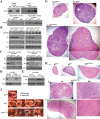
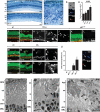
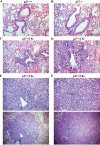
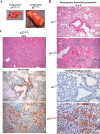
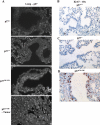
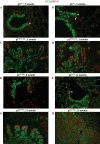
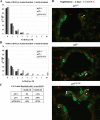
Comment in
-
Duality of p27Kip1 function in tumorigenesis.Genes Dev. 2007 Jul 15;21(14):1703-6. doi: 10.1101/gad.1583207. Genes Dev. 2007. PMID: 17639075 Review. No abstract available.
Similar articles
-
Duality of p27Kip1 function in tumorigenesis.Genes Dev. 2007 Jul 15;21(14):1703-6. doi: 10.1101/gad.1583207. Genes Dev. 2007. PMID: 17639075 Review. No abstract available.
-
A non-canonical role for p27Kip1 in restricting proliferation of corneal endothelial cells during development.PLoS One. 2020 Jan 13;15(1):e0226725. doi: 10.1371/journal.pone.0226725. eCollection 2020. PLoS One. 2020. PMID: 31929545 Free PMC article.
-
p27Kip1 repression of ErbB2-induced mammary tumor growth in transgenic mice involves Skp2 and Wnt/beta-catenin signaling.Cancer Res. 2006 Sep 1;66(17):8529-41. doi: 10.1158/0008-5472.CAN-06-0149. Cancer Res. 2006. PMID: 16951165
-
Distinct roles for p53, p27Kip1, and p21Cip1 during tumor development.Oncogene. 2004 Jan 29;23(4):905-13. doi: 10.1038/sj.onc.1207220. Oncogene. 2004. PMID: 14647411
-
p27kip1: a new multiple endocrine neoplasia gene?Neuroendocrinology. 2011;93(1):19-28. doi: 10.1159/000320366. Epub 2010 Oct 27. Neuroendocrinology. 2011. PMID: 20980721 Review.
Cited by
-
Large miRNA survival analysis reveals a prognostic four-biomarker signature for triple negative breast cancer.Genet Mol Biol. 2020 Mar 2;43(1):e20180269. doi: 10.1590/1678-4685-GMB-2018-0269. eCollection 2020. Genet Mol Biol. 2020. PMID: 31487369 Free PMC article.
-
Pax6 is required for normal cell-cycle exit and the differentiation kinetics of retinal progenitor cells.PLoS One. 2013 Sep 20;8(9):e76489. doi: 10.1371/journal.pone.0076489. eCollection 2013. PLoS One. 2013. PMID: 24073291 Free PMC article.
-
Familial pituitary tumor syndromes.Nat Rev Endocrinol. 2009 Aug;5(8):453-61. doi: 10.1038/nrendo.2009.126. Epub 2009 Jun 30. Nat Rev Endocrinol. 2009. PMID: 19564887 Review.
-
miR-181a regulates cap-dependent translation of p27(kip1) mRNA in myeloid cells.Mol Cell Biol. 2009 May;29(10):2841-51. doi: 10.1128/MCB.01971-08. Epub 2009 Mar 9. Mol Cell Biol. 2009. PMID: 19273599 Free PMC article.
-
BCR-ABL1 promotes leukemia by converting p27 into a cytoplasmic oncoprotein.Blood. 2014 Nov 20;124(22):3260-73. doi: 10.1182/blood-2013-04-497040. Epub 2014 Oct 7. Blood. 2014. PMID: 25293778 Free PMC article.
References
-
- Ayvazian L.F. Desquamative interstitial pneumonia. A systemic disease and precancerous lesion? J. Med. Soc. N. J. 1974;71:115–119. - PubMed
-
- Besson A., Assoian R.K., Roberts J.M., Assoian R.K., Roberts J.M., Roberts J.M. Regulation of the cytoskeleton: An oncogenic function for CDK inhibitors? Nat. Rev. Cancer. 2004a;4:948–955. - PubMed
-
- Besson A., Gurian-West M., Schmidt A., Hall A., Roberts J.M., Gurian-West M., Schmidt A., Hall A., Roberts J.M., Schmidt A., Hall A., Roberts J.M., Hall A., Roberts J.M., Roberts J.M. p27Kip1 modulates cell migration through the regulation of RhoA activation. Genes & Dev. 2004b;18:862–876. - PMC - PubMed
-
- Besson A., Gurian-West M., Chen X., Kelly-Spratt K.S., Kemp C.J., Roberts J.M., Gurian-West M., Chen X., Kelly-Spratt K.S., Kemp C.J., Roberts J.M., Chen X., Kelly-Spratt K.S., Kemp C.J., Roberts J.M., Kelly-Spratt K.S., Kemp C.J., Roberts J.M., Kemp C.J., Roberts J.M., Roberts J.M. A pathway in quiescent cells that controls p27Kip1 stability, subcellular localization and tumor suppression. Genes & Dev. 2006;20:47–64. - PMC - PubMed
Publication types
MeSH terms
Substances
Grants and funding
LinkOut - more resources
Full Text Sources
Other Literature Sources
Molecular Biology Databases
Miscellaneous
